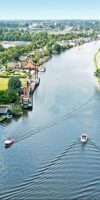Filter by:
News
Stay informed of all the latest developments in the field of water and subsurface.

Novel irrigated areas identification framework for better water management practices
To identify irrigated areas Deltares and WUR (Wageningen University & Research) researchers have set up a novel framework that combines hydrological modeling and satellite observations of land surface temperature (LST). Their approach provides valuable insights that can lead to more sustainable and efficient water management practices, starting in the Rhine River basin.
Deltares signs cooperation agreement with Thailand
Deltares has signed a Memorandum of Understanding (MoU) with Thailand’s Royal Irrigation Department (RID), Chulalongkorn University (CU), and the Faculty of Engineering at Kasetsart University (KU). Over the coming years, we will work together to exchange knowledge, improve technical skills, and work on relevant projects.
Future-proofing inland shipping
How can inland shipping adapt to and gain more control over the consequences of a changing climate? Over the past two years, 15 parties have been working on this issue in the TRANS2 research project, led by Deltares; the transition to climate-proof and sustainable Rotterdam hinterland transport.
Sea level rise after the last ice age: more knowledge
Thanks to new geological data, we now know more about how fast and how much the global sea level rose after the last ice age, some 11,700 years ago. This information is of great importance for our current understanding of the impact of global warming on ice caps and thus on sea level rise. Researchers from Deltares, Utrecht University, TNO Netherlands Geological Service, Delft University of Technology, the Netherlands Institute for Sea Research (NIOZ), University of Leeds, University of Sheffield, University of Amsterdam, LIAG and BGR published their findings in the journal Nature.
Flexible solutions for sustainable drinking water production
How can sustainable drinking water be ensured in the future, given the intensifying water scarcity? The Netherlands, where groundwater supplies over 60% of drinking water, faces growing pressures from land use competition, contamination and climate change. In this paper ‘Flexible solution concepts for sustainable drinking water production in the Netherlands’ innovative, possible and flexible solutions are explored.
A century of dam safety: Five key insights
Dams are essential for flood protection, water resources management, energy, and food security. However, their failure can lead to devastating consequences, as recent disasters have demonstrated. A new study, published in Nature Water by researchers from Deltares, IHE Delft, and Imperial College London, presents a detailed global analysis of dam failure probability from 1900 until present. This work unveils key factors behind the evolution of large dams’ failures and offers insights into future trends.
YES!Delft and Deltares join forces to accelerate innovation
YES!Delft and Deltares have taken a significant step towards accelerating technological innovation by signing a strategic partnership agreement. This collaboration opens up exciting new opportunities for startups and promises to drive innovation forward at an unprecedented pace.
New study explores the future of ‘living with water’
A new study by Deltares sheds light on the role of ‘living with water’ (in Dutch: Meebewegen) as a strategy for climate adaptation in the Netherlands. Although we are known worldwide for our advanced flood defences, we will be increasingly confronted with the challenges of sea level rise, extreme rainfall and water shortages. This study examines the views of different experts about the feasibility and desirability of the ‘living with water’ strategy in Dutch water management in the future. The results of the study were presented this week in the journal Environmental Research: Climate.
Keeping our rivers navigable with flexible groynes
There are thousands of traditional groynes in Dutch rivers. They are essential to keep waterways navigable and manage river ice. However, maintenance work on these groynes is costly and time-consuming. In a unique alliance between the government, private parties and knowledge institutes, including Deltares, an innovative alternative has been developed: the flexible groyne.
Modelling effect of future land use on our health
Last year, we published a set of future scenarios for the Netherlands, focussing on issues relating to the health of people, animals and the environment, often collectively referred to as ‘One Health’. Now we have created future land use maps for each of these scenarios for 2050, enabling us to model future health risks.
Rapid design of Nature-based Solutions with new tool
To make Nature-based Solutions easier to apply, Witteveen+Bos and Deltares are jointly developing a tool. It allows natural solutions to be integrated into hydrological models and to quickly see their impact on river basins under different climate scenarios. This improves designs of Nature-based Solutions, supports co-creation processes and helps informed decision-making on water management and climate adaptation.
Broadening the assessment framework for river policy
The major rivers that flow through the Netherlands have a significant impact on our nature, culture, economy, and food and water supplies. To quantify the effects of our river and floodplain management on these so-called ecosystem services, a broader assessment framework has been developed by Sien Kok, a researcher at Deltares and WUR. She did this as part of her doctoral research through the European project MERLIN, which promotes the restoration of rivers.
